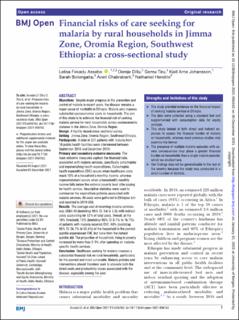Financial risks of care seeking for malaria by rural households in Jimma Zone, Oromia Region, Southwest Ethiopia: a cross-sectional study
Assebe, Lelisa Fekadu; Dillu, Dereje; Tiru, Gemu; Johansson, Kjell Arne; Bolongaita, Sarah; Chakrabarti, Averi; Hendrix, Nathaniel
Journal article, Peer reviewed
Published version

Åpne
Permanent lenke
https://hdl.handle.net/11250/2977944Utgivelsesdato
2021Metadata
Vis full innførselSamlinger
Sammendrag
Objectives
Despite major progress in the prevention and control of malaria in recent years, the disease remains a major cause of morbidity in Ethiopia. Malaria also imposes substantial socioeconomic costs on households. The aim of this study is to estimate the financial risk of seeking malaria service for rural households across socioeconomic statuses in the Jimma Zone, Oromia Region.
Design
A facility-based cross-sectional survey.
Setting
Jimma Zone, Oromia Region, Southwest Ethiopia.
Participants
A total of 221 patients with malaria from 10 public health facilities were interviewed between September 2018 and December 2019.
Primary and secondary outcome measures
The main outcome measures capture the financial risks associated with malaria services, specifically catastrophic and impoverishing health expenditures. Catastrophic health expenditure (CHE) occurs when healthcare costs reach 10% of a household’s monthly income, whereas impoverishment occurs when a household’s monthly income falls below the national poverty level after paying for health service. Descriptive statistics were used to summarise the expenditure patterns associated with malaria services. All costs were gathered in Ethiopian birr and reported in 2019 US$.
Results
The average cost of receiving malaria services was US$4.40 (bootstrap 95% CI: 3.6 to 5.3), with indirect costs accounting for 52% of total costs. Overall, at the 10% threshold, 12% (bootstrap 95% CI: 8.1% to 16.7%) of patients with malaria incurred CHE: 40% (bootstrap 95% CI: 26.7% to 55.6%) of the household in the poorest quintile experienced CHE, but none from the richest quintile did. The proportion of households living in poverty increased by more than 2-3% after spending on malaria-specific health services.
Conclusion
Healthcare seeking for malaria imposes a substantial financial risk on rural households, particularly for the poorest and most vulnerable. Malaria policies and interventions should therefore seek to alleviate both the direct costs and productivity losses associated with the disease, especially among the poor.
